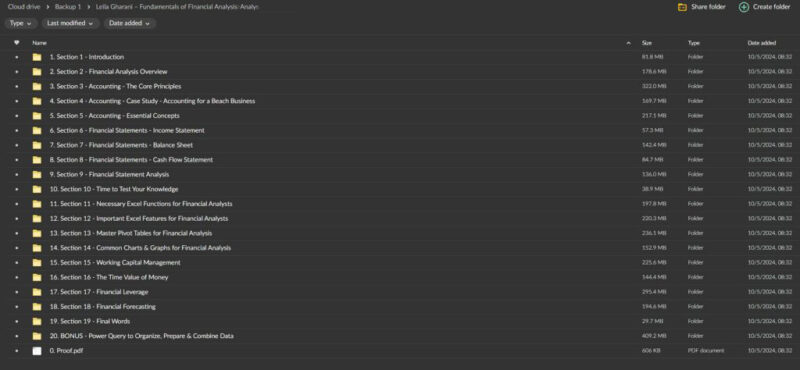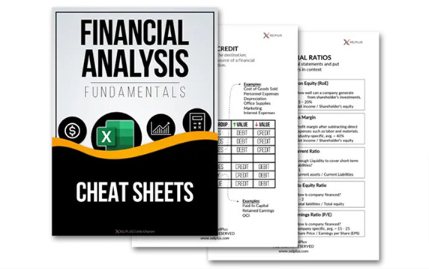Leila Gharani – Fundamentals of Financial Analysis
Leila Gharani – Fundamentals of Financial Analysis
Original price was: $997.00.$30.00Current price is: $30.00.
3.45 GB

After completing your purchase, you will receive a secure Mega.nz link to access your course materials. Follow these steps to access your course:
If you encounter any issues accessing the course via Mega.nz, please contact our support team, and we will provide you with an alternative Google Drive link.
Why Choose beastcourses?
- Permanent Access Links
- 24/7 Expert Support
- Instant Access to HD Quality Courses
- 100% Safe & Secure Checkout
- Courses Are Updated Regularly
Leila Gharani – Fundamentals of Financial Analysis

Master Financial Literacy with the Leila Gharani – Fundamentals of Financial Analysis Course
Do you want to make smarter financial decisions for your business, career, or investments? Understanding financial data is a critical skill that can give you a strategic edge in today’s fast-paced business environment. However, mastering financial analysis can feel overwhelming, especially if you lack a formal background in finance. The Fundamentals of Financial Analysis course by Leila Gharani is designed to bridge that gap, offering a step-by-step, practical approach to analyzing financial statements, identifying key trends, and making data-driven decisions. With this course, you’ll gain the confidence to interpret financial information and apply it effectively in any professional context.
Why Is This Course Worth Buying?
The Leila Gharani – Fundamentals of Financial Analysis course is not your typical finance class. Developed by Leila Gharani, a renowned finance expert and educator, this program combines real-world applications, practical tools, and comprehensive modules to help you understand the intricacies of financial analysis. It’s perfect for finance professionals looking to enhance their skills, business owners aiming to gain deeper insights into their financial health, and anyone interested in learning how to evaluate investment opportunities. With a structured curriculum that covers everything from foundational concepts to advanced techniques, this course provides a holistic understanding of financial analysis that you won’t find anywhere else.
What Does the Fundamentals of Financial Analysis Course Include?
How Does Module 1 Introduce You to the Essentials of Financial Analysis?
Why Is It Important to Start with a Strong Foundation?
Before diving into complex financial models and analysis techniques, it’s essential to build a solid foundation. Module 1, titled Introduction to Financial Analysis, sets the stage by breaking down key concepts and terminology. You’ll explore the basics of financial analysis, including its purpose, scope, and impact on decision-making. This module covers:
- Overview of Financial Analysis: Understand the importance of financial analysis in evaluating business performance, guiding strategic decisions, and assessing investment opportunities.
- Setting Goals and Objectives: Learn how to define clear goals and objectives for your financial analysis, ensuring that you’re focusing on the right metrics to support informed decisions.
- Key Concepts and Terminology: Familiarize yourself with essential financial terms such as revenue, expenses, profitability, liquidity, and solvency to build a solid vocabulary that will serve as a foundation for more complex topics.
This introductory module is crucial for creating a framework that guides the rest of your learning, providing a clear path toward mastering financial analysis.
What Will You Learn in Module 2: Financial Statement Analysis?
How Can Analyzing Financial Statements Enhance Decision-Making?
Financial statements are the backbone of any financial analysis. In Module 2, Financial Statement Analysis, you’ll learn how to break down and interpret the three main financial statements: the balance sheet, the income statement, and the cash flow statement. You’ll explore:
- Balance Sheet Analysis: Discover how to assess a company’s assets, liabilities, and equity to understand its financial position. Learn to calculate key ratios that reveal insights into liquidity, leverage, and overall stability.
- Income Statement Analysis: Delve into revenue and expense breakdowns to evaluate a company’s profitability. Understand how to analyze margins and trends to determine business efficiency and performance.
- Cash Flow Statement Analysis: Learn to track cash inflows and outflows to assess a company’s liquidity and cash management. Gain insights into operational efficiency, investment activities, and financing strategies.
By mastering these skills, you’ll be able to interpret the financial health of any organization, making you a valuable asset in any finance-related role.
How Does Module 3 Help You Master Ratio Analysis?
Why Are Financial Ratios Essential for Evaluating Business Health?
In Module 3, Ratio Analysis, you’ll dive into the world of financial ratios—powerful tools that provide a quick snapshot of a company’s performance. You’ll learn how to calculate, interpret, and apply various types of ratios, including:
- Liquidity Ratios: Assess a company’s ability to meet short-term obligations, revealing its financial flexibility.
- Profitability Ratios: Measure a company’s efficiency in generating profits relative to its revenue, assets, or equity.
- Efficiency Ratios: Analyze how effectively a company utilizes its assets and manages its operations.
- Solvency Ratios: Evaluate a company’s long-term stability and ability to meet debt obligations.
This module also highlights common pitfalls and limitations of ratio analysis, teaching you how to use ratios in context to avoid misleading conclusions.
How Does Financial Modeling Elevate Your Analytical Skills?
What Are the Benefits of Learning Financial Modeling?
Why Is Excel a Powerful Tool for Financial Analysis?
Module 4, Financial Statement Modeling, introduces you to the art of building dynamic financial models using Excel. You’ll learn to:
- Construct Financial Models from Scratch: Understand the step-by-step process of building a financial model that accurately reflects a company’s financial position and performance.
- Create Projections and Forecasts: Learn how to use your model to project future financial outcomes, helping you anticipate challenges and opportunities.
- Implement Best Practices in Excel: Discover tips and techniques for using Excel effectively, ensuring your models are both robust and easy to interpret.
By the end of this module, you’ll have the skills to build your financial models, making complex data more accessible to analyze and present.
How Does the Course Teach Advanced Analysis Techniques?
How Can Scenario Analysis and Monte Carlo Simulations Improve Decision-Making?
Module 5, Advanced Financial Analysis Techniques, takes your skills to the next level by introducing more sophisticated methods. You’ll explore:
- Scenario Analysis: Learn how to conduct what-if scenarios to understand the potential impact of various factors on financial performance.
- Monte Carlo Simulations: Using statistical techniques to model risk and uncertainty provides a deeper understanding of possible outcomes and probabilities.
- Data Visualization Techniques: Discover how to present complex financial data using charts, graphs, and other visualization tools to communicate your findings effectively.
These advanced techniques will empower you to analyze financial data with greater depth and precision, making you a more versatile and skilled analyst.
How Does Module 6 Bring It All Together?
What Real-World Case Studies Will You Explore?
Putting It All Together – Case Studies, the final module, focuses on applying everything you’ve learned through practical, real-world scenarios. You’ll work through:
- Real-World Case Studies: Analyze the financial statements of actual companies, applying the techniques and principles covered in the course.
- Scenario-Based Exercises: Tackle complex financial problems, using your analytical skills to develop solutions and make strategic recommendations.
- Presenting Your Findings: Learn best practices for reporting and presenting your analysis, ensuring that your insights are communicated clearly and persuasively.
This module reinforces your learning and gives you the confidence to apply your skills in professional settings.
Who Should Take the Fundamentals of Financial Analysis Course?
Is This Course Right for You?
The Leila Gharani – Fundamentals of Financial Analysis course is ideal for:
- Finance Professionals: Enhance your analytical skills and deepen your understanding of financial data.
- Business Owners: Gain the insights needed to make informed decisions and manage your company’s finances effectively.
- Investors: Learn to evaluate potential investments and assess financial risks more confidently.
- Anyone Interested in Finance: Whether considering a career change or simply wanting to build your financial literacy, this course provides a solid foundation.
Unlock the Secrets of Financial Analysis with Leila Gharani!
Why Should You Enroll Today?
The Fundamentals of Financial Analysis course is more than just a learning experience—it’s a comprehensive program that equips you with the skills and confidence to analyze financial data like a pro. With Leila Gharani’s expert guidance, you’ll master the tools and techniques needed to make informed financial decisions, opening up new career growth and success opportunities.
Enroll today and take the first step toward becoming a financial analysis expert. With the Leila Gharani – Fundamentals of Financial Analysis, you’ll gain a deep understanding of financial data, empowering you to unlock your full potential in the world of finance!






